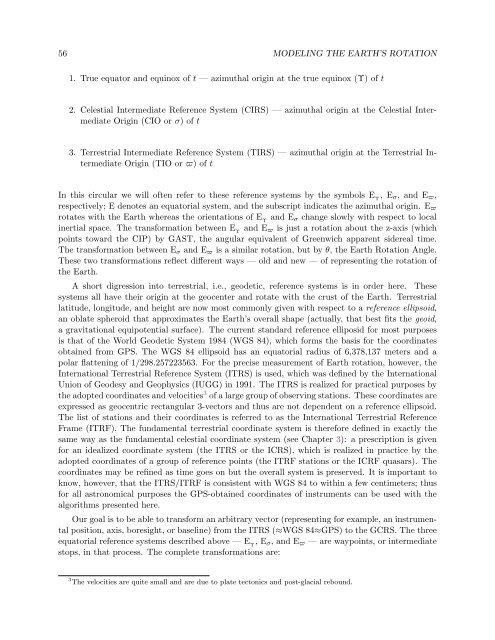USNO Circular 179 - U.S. Naval Observatory
USNO Circular 179 - U.S. Naval Observatory
USNO Circular 179 - U.S. Naval Observatory
Create successful ePaper yourself
Turn your PDF publications into a flip-book with our unique Google optimized e-Paper software.
56 MODELING THE EARTH’S ROTATION<br />
1. True equator and equinox of t — azimuthal origin at the true equinox (Υ) of t<br />
2. Celestial Intermediate Reference System (CIRS) — azimuthal origin at the Celestial Intermediate<br />
Origin (CIO or σ) of t<br />
3. Terrestrial Intermediate Reference System (TIRS) — azimuthal origin at the Terrestrial Intermediate<br />
Origin (TIO or ϖ) of t<br />
In this circular we will often refer to these reference systems by the symbols E Υ , Eσ, and Eϖ,<br />
respectively; E denotes an equatorial system, and the subscript indicates the azimuthal origin. Eϖ<br />
rotates with the Earth whereas the orientations of E Υ and Eσ change slowly with respect to local<br />
inertial space. The transformation between E Υ and Eϖ is just a rotation about the z-axis (which<br />
points toward the CIP) by GAST, the angular equivalent of Greenwich apparent sidereal time.<br />
The transformation between Eσ and Eϖ is a similar rotation, but by θ, the Earth Rotation Angle.<br />
These two transformations reflect different ways — old and new — of representing the rotation of<br />
the Earth.<br />
A short digression into terrestrial, i.e., geodetic, reference systems is in order here. These<br />
systems all have their origin at the geocenter and rotate with the crust of the Earth. Terrestrial<br />
latitude, longitude, and height are now most commonly given with respect to a reference ellipsoid,<br />
an oblate spheroid that approximates the Earth’s overall shape (actually, that best fits the geoid,<br />
a gravitational equipotential surface). The current standard reference elliposid for most purposes<br />
is that of the World Geodetic System 1984 (WGS 84), which forms the basis for the coordinates<br />
obtained from GPS. The WGS 84 ellipsoid has an equatorial radius of 6,378,137 meters and a<br />
polar flattening of 1/298.257223563. For the precise measurement of Earth rotation, however, the<br />
International Terrestrial Reference System (ITRS) is used, which was defined by the International<br />
Union of Geodesy and Geophysics (IUGG) in 1991. The ITRS is realized for practical purposes by<br />
the adopted coordinates and velocities 3 of a large group of observing stations. These coordinates are<br />
expressed as geocentric rectangular 3-vectors and thus are not dependent on a reference ellipsoid.<br />
The list of stations and their coordinates is referred to as the International Terrestrial Reference<br />
Frame (ITRF). The fundamental terrestrial coordinate system is therefore defined in exactly the<br />
same way as the fundamental celestial coordinate system (see Chapter 3): a prescription is given<br />
for an idealized coordinate system (the ITRS or the ICRS), which is realized in practice by the<br />
adopted coordinates of a group of reference points (the ITRF stations or the ICRF quasars). The<br />
coordinates may be refined as time goes on but the overall system is preserved. It is important to<br />
know, however, that the ITRS/ITRF is consistent with WGS 84 to within a few centimeters; thus<br />
for all astronomical purposes the GPS-obtained coordinates of instruments can be used with the<br />
algorithms presented here.<br />
Our goal is to be able to transform an arbitrary vector (representing for example, an instrumental<br />
position, axis, boresight, or baseline) from the ITRS (≈WGS 84≈GPS) to the GCRS. The three<br />
equatorial reference systems described above — E Υ , Eσ, and Eϖ — are waypoints, or intermediate<br />
stops, in that process. The complete transformations are:<br />
3 The velocities are quite small and are due to plate tectonics and post-glacial rebound.


